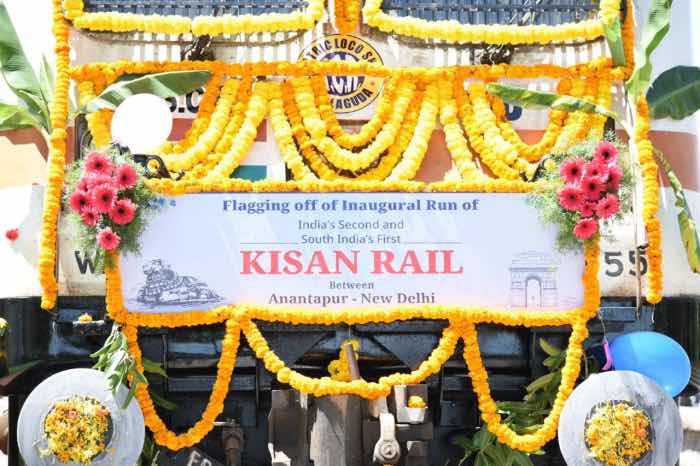Indian Railways, with its pan-India network, forms an integral part of the government plan to raise incomes in the farm sector by encouraging transportation by rail. The introduction of Kisan Rails has given farmers wide access to Indian markets. Kisan Rail has so far carried 2.7 lakh tonnes of consignment. Till now, 60 routes have been operationalised.
Railways have been relentlessly pursuing with various stakeholders – including the Ministry of Agriculture & Farmers Welfare, state governments, local bodies and Mandis – for the expansion of Kisan Rail services.
In compliance with the announcement made in Union Budget 2020-21, Kisan Rails have been introduced by Indian Railways – to move perishables and farm-produce (including fruits, vegetables, meat, poultry, fishery and dairy products) from production or surplus regions to consumption or deficient regions.
Kisan Rail Services in India: The Journey so far in a year
The first train under the Kisan Rail scheme – between Devlali (Mah) and Danapur (Bihar) – was flagged off by Minister of Railways Piyush Goyal and Minister of Agriculture & Farmers’ Welfare Narendra Singh Tomar on 7 August 2020. This train has subsequently been extended to run between Sangola (Mah) and Muzaffarpur (Bihar).
The 100th trip under Kisan Rail scheme – between Sangola (Mah) and Shalimar (WB) – was flagged-off by Prime Minister Narendra Modi on 28 December 2020.
Till 18 June 2021, a total of 850 trips of Kisan Rails were operated on 60 routes, transporting more than 2.7 lakh Tonnes of consignments.
What are the salient features of Kisan Rail Yojana
• Enables movement of perishables including fruits, vegetables, meat, poultry, fishery and dairy products from the production or surplus regions to consumption or deficient regions;
• Speedy movement ensures minimum damage during transit;
• Enables farmers to utilise the vast railway network to gain access to distant, bigger and more lucrative markets;
• 50 per cent subsidy is given in freight (being borne by Ministry of Food Processing Industries under ‘Operation Greens – TOP to Total’ scheme) for transportation of fruits and vegetables;
• Based on the concept of multi-commodity, multi consigner, multi consignee, multi stoppages, time-tabled trains – to help small farmers with lesser produce also to transport their consignment without any middleman;
• No minimum limit on the quantity that can be booked, enabling even small and marginal farmers to reach bigger and distant markets;
• End-consumers (at bigger cities and consumption centres) get fresher produce at cheaper prices, due to reduction in transportation time as well as costs.
From orange to onion and potato to tomato: What all Kisan Rail transports
Main crops/farm-produce transported via Kisan Rail train include oranges, onion, potato, banana, mango, tomato, pomegranate, custard apple, capsicum, chikoo, carrot, etc.
Kisan Rail routes are already out. These trains run on time-tabled paths and are being monitored for punctuality as well as to ensure that perishable commodities reach their destinations within due time, and also that Indian Railways’ resources are utilized in the most optimal manner.
All the Kisan Rail train services are being charged at ‘P-scale’ of Parcel tariff.
Under the ‘Operation Greens – TOP to Total’ scheme of the Ministry of Food Processing Industries (MoFPI) 50% subsidy in freight is granted on transportation of fruits and vegetables through Kisan Rail trains services.
Since the introduction of this subsidy scheme (with effect from 14th October 2020) till 15th June 2021, an amount of approximately Rs 52.38 crore has been disbursed as subsidy through Kisan Rail.









India braces for heatwave: Top tips to stay safe in sweltering conditions
Stress managemnt: 10 tips to manage anxiety issues
Flight cancelled or delayed? Guidelines you must know